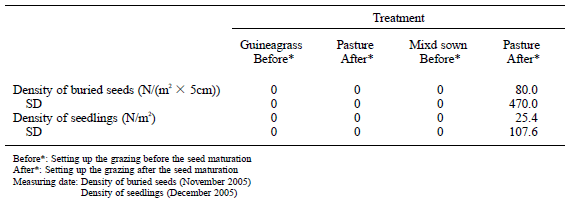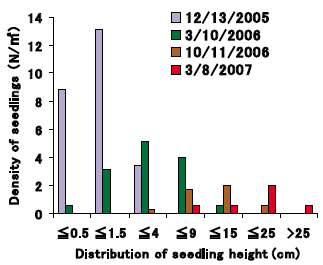Management method for regeneration of stylo in guineagrass-stylo mixed pasture
Description
Since the productivity of guineagrass (Panicum maximum) is high, its cultivation has expanded in the tropical savannas of South America. However, if no fertilizer is applied after establishment of guineagrass pasture, pasture productivity falls sharply every year, making it important to use legumes as an alternative nitrogen source. However, the maintenance of legumes in pasture is difficult in tropical savanna, since they are grazed selectively. Selection of legumes that show persistence under grazing pressure and the establishment of utilization with guineagrass is thus needed. This study aimed to maintain stylo (Stylothantes capitata and S. macrocephala) in mixed sown pasture of guineagrass and stylo by promoting its regeneration. This study was conducted in collaboration with JATAK in Brazil.
Guineagrass pasture (seeding rate 6 kg/ha) and guineagrass-stylo mixed sown pasture (seeding rate 3 kg/ha and 4 kg/ha, respectively) were established early in December 2004. Each pasture was then mowed and divided into two treatments: grazed before and after seed maturity of the stylo. Over one year, the dry matter yield in the mixed sown pasture was 30.6 tons/ha/yr, 50% more than in the guineagrass pasture.
In the mixed sown pasture grazed after seed maturity, the buried seed density of the stylo in the soil, sampled in mid-November just before the rainy season, reached about 80 seeds/m2 at a depth of 5 cm (Table 1). This density is equivalent to one half of the seeding rate. However, no buried seed bank was formed in the mixed sown pasture grazed before seed maturity. In the mixed sown pasture grazed after seed maturity, stylo seeds were present at a high density in cattle dung, and seed dispersal was performed efficiently by cattle defecation. However, the seed was not contained in cattle dung in the guineagrass pasture or the mixed sown pasture grazed before seed maturity.
In addition, numerous stylo seedlings (25.4/m2) appeared at the beginning of the rainy season (Fig. 1). Seedling density had decreased to 3.7/m2 about one year later. However, about 70% of the seedlings grew to over 15 cm in height, enabling regeneration.
Stylo is able to regenerate in mixed sown pasture if it is grazed after seed maturity. Seed dispersal is conducted via cattle dung, forming a buried seed bank, allowing the pasture to maintain high productivity.
Figure, table
-
Table 1. Density of buried seeds and seedlings of stylo (Stylosanthes capitata + S. macrocephala).
-
Fig. 1. Change in distribution of seedling heights of stylo.
- Affiliation
-
Japan International Research Center for Agricultural Sciences Animal Production and Grassland Division
- Term of research
-
(FY2004~)FY2006(FY2006~2008)
- Responsible researcher
-
SHIMODA Katsuhisa ( Animal Production and Grassland Division )
SHIOYA Tetsuo ( National Federation of Japanese Immigrant Agricultural Cooperation )
- ほか
- Publication, etc.
-
SHIMODA, K. et al. (2006) Japanese journal of grassland science. 52 Suppl. 284-285.
- Japanese PDF
-
2006_seikajouhou_A4_ja_Part15.pdf535.22 KB


